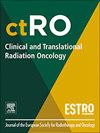Changes in prostate volume during prostate SBRT delivered on an MR-Linac and correlation with acute toxicity
IF 2.7
3区 医学
Q3 ONCOLOGY
引用次数: 0
Abstract
Purpose
We evaluated prostate volume changes during stereotactic body radiation therapy (SBRT) using serial MRI, identifying variables associated with prostatic swelling and their correlation with acute toxicity.
Methods
Fifty-two patients with localized prostate cancer, androgen deprivation therapy naive, underwent SBRT to 40 Gy in five fractions on an MRI-Linear Accelerator with dominant intraprostatic lesion boosts to 45 Gy when present. Whole prostate (WP) and transition zone (TZ) measurements were assessed on the pre-treatment T2 MRI obtained for daily adaptation. Volumes were calculated using the ellipsoid formula. Non-transition zone (nonTZ) measures = WP values − TZ values. Transition zone index (TZI) = TZ volume/WP volume. Acute toxicity and International Prostate Symptom Scores (IPSS) were recorded.
Results
Prostate volume increased significantly over the first four fractions, peaking at fraction 4 with mean percent and absolute changes of 21 % and 7.8 cc, respectively. Standardized TZ measures were strongly associated with WP volume (β per SD 10.60–12.78; all p < 0.001), whereas the only nonTZ dimension weakly associated was anteroposterior (β per SD 1.78). Each standard deviation increase in baseline TZ parameters doubled to tripled the odds of significant swelling (≥10 cc) (all p ≤ 0.011). The interaction of baseline TZI with later fractions was significantly associated with swelling (fraction 4: β = 12.06, p = 0.020; fraction 5: β = 10.96, p = 0.036), but not baseline TZI alone. Neither Grade 2+ genitourinary toxicity nor IPSS changes were associated with prostate measures or TZI.
Conclusions
Prostate volume significantly increases during SBRT, primarily corresponding with TZ volumetric changes. Baseline TZ measurements most strongly predict high-volume swelling. Acute toxicity was not associated with volumetric change.
MR-Linac给药前列腺SBRT期间前列腺体积的变化及其与急性毒性的相关性
目的:利用系列MRI评估立体定向全身放射治疗(SBRT)期间前列腺体积的变化,确定与前列腺肿胀相关的变量及其与急性毒性的相关性。方法52例未接受雄激素剥夺治疗的局限性前列腺癌患者,在mri线性加速器上分五次接受40 Gy的SBRT治疗,当前列腺内显性病变存在时,SBRT强度为45 Gy。全前列腺(WP)和过渡区(TZ)测量在治疗前每日适应获得的T2 MRI上评估。使用椭球体公式计算体积。非过渡区(nonTZ)测量值= WP值−TZ值。过渡区指数(TZI) = TZ体积/WP体积。记录急性毒性及国际前列腺症状评分(IPSS)。结果前列腺体积在前4个部位明显增大,在第4个部位达到峰值,平均百分比和绝对变化分别为21%和7.8 cc。标准化TZ测量值与WP体积密切相关(β / SD 10.60-12.78;所有p <;0.001),而唯一与非tz维度弱相关的是正相关性(β / SD 1.78)。基线TZ参数每增加一个标准差,显著肿胀(≥10 cc)的几率增加一至三倍(均p≤0.011)。基线TZI与后期分数的相互作用与肿胀显著相关(分数4:β = 12.06, p = 0.020;分数5:β = 10.96, p = 0.036),但单独的基线TZI没有。2+级泌尿生殖系统毒性和IPSS变化均与前列腺测量或TZI无关。结论SBRT过程中前列腺体积明显增加,主要与TZ体积变化相对应。基线TZ测量最能预测高容量肿胀。急性毒性与体积变化无关。
本文章由计算机程序翻译,如有差异,请以英文原文为准。
求助全文
约1分钟内获得全文
求助全文
来源期刊

Clinical and Translational Radiation Oncology
Medicine-Radiology, Nuclear Medicine and Imaging
CiteScore
5.30
自引率
3.20%
发文量
114
审稿时长
40 days
 求助内容:
求助内容: 应助结果提醒方式:
应助结果提醒方式:


